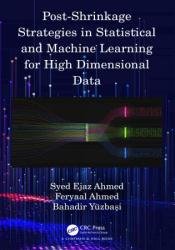 Название: Post-Shrinkage Strategies in Statistical and Machine Learning for High Dimensional Data
Название: Post-Shrinkage Strategies in Statistical and Machine Learning for High Dimensional DataАвтор: Syed Ejaz Ahmed, Feryaal Ahmed, Bahadir Yuzbası
Издательство: Springer
Год: 2023
Страниц: 409
Язык: английский
Формат: pdf (true)
Размер: 18.7 MB
This book presents some post-estimation and predictions strategies for the host of useful statistical models with applications in Data Science. It combines statistical learning and Machine Learning techniques in a unique and optimal way. It is well-known that Machine Learning methods are subject to many issues relating to bias, and consequently the mean squared error and prediction error may explode. For this reason, we suggest shrinkage strategies to control the bias by combining a submodel selected by a penalized method with a model with many features. Further, the suggested shrinkage methodology can be successfully implemented for high dimensional data analysis. Many researchers in statistics and medical sciences work with Big Data. They need to analyse this data through statistical modelling. Estimating the model parameters accurately is an important part of the data analysis. This book may be a repository for developing improve estimation strategies for statisticians. This book will help researchers and practitioners for their teaching and advanced research, and is an excellent textbook for advanced undergraduate and graduate courses involving shrinkage, statistical, and Machine Learning.
The term learning in Computer Science is referred to as a branch of Artificial Intelligence (AI) the design and development of algorithms that allows computers to evolve based on empirical data. The type of algorithm is what dictates the success of the Machine Learning (ML) system. Recently, Machine Learning has also been referred to as statistical learning because these algorithms have foundations in statistics. There are two main classes of algorithms, supervised and unsupervised learning. Models that people have most likely encountered are usually supervised learning, for example, prediction via logistic or multinomial regression. The differentiating factor between these two classes, is that supervised learning is concerned
with data that has labels and the researcher has an idea of what they are looking to predict.
In contrast, unsupervised learning is used when the researcher does not necessarily know what the data entails. In current times, people are overloaded with excessive data and simply figuring out what we are looking at can be a daunting task. Unsupervised learning techniques aids in exploring data, where no assumptions can be made. For example, survey data or medical data can be multidimensional and difficult to interpret; unsupervised algorithms can provide guidance on which variables are pertinent by providing representative variable identification. Unsupervised learning looks at how the data is grouped naturally based on where the data points exist in its multidimensional space. Unsupervised learning used with supervised learning can be a very powerful tool. One can input variables found via unsupervised methods into supervised prediction models, creating a stronger prediction model if such variables are found significant.
To provide a clear guide, this chapter will investigate popular classification and regression Machine Learning techniques. Classification methods range from the simplest of models to black-box learning. Regression models will build up from the basics and grow in complexity. Logistic regression, multivariate adaptive regression spline (MARS), k-nearest neighbours (kNN), neural nets, support vector machine, random forest, and gradient boosting machine will be discussed in the Chapter 2.
R has been a saving grace for many data scientists and statisticians alike. As research progresses, so have the computing packages. Table 2.1 is a list of R packages available that can perform the aforementioned Machine Learning techniques.
- The book succinctly reveals the bias inherited in Machine Learning method and successfully provides tools, tricks and tips to deal with the bias issue.
- Expertly sheds light on the fundamental reasoning for model selection and post estimation using shrinkage and related strategies.
- This presentation is fundamental, because shrinkage and other methods appropriate for model selection and estimation problems and there is a growing interest in this area to fill the gap between competitive strategies.
- Application of these strategies to real life data set from many walks of life.
- Analytical results are fully corroborated by numerical work and numerous worked examples are included in each chapter with numerous graphs for data visualization.
- The presentation and style of the book clearly makes it accessible to a broad audience. It offers rich, concise expositions of each strategy and clearly describes how to use each estimation strategy for the problem at hand.
- This book emphasizes that statistics/statisticians can play a dominant role in solving Big Data problems, and will put them on the precipice of scientific discovery.
- The book contributes novel methodologies for HDDA and will open a door for continued research in this hot area.
- The practical impact of the proposed work stems from wide applications. The developed computational packages will aid in analyzing a broad range of applications in many walks of life.
Скачать Post-Shrinkage Strategies in Statistical and Machine Learning for High Dimensional Data